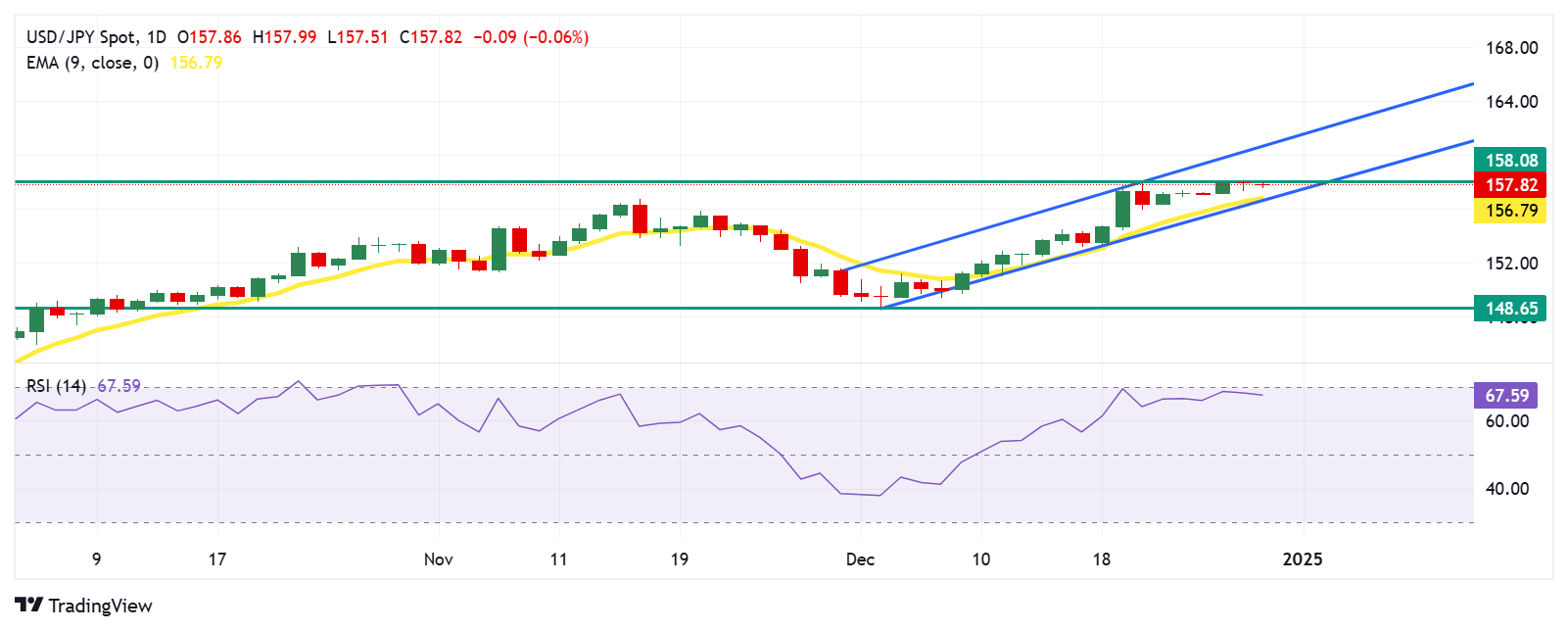- The Japanese Yen holds ground as traders expect the BoJ to deliver an interest rate hike in January.
- Japan’s Jibun Bank Manufacturing PMI reached 49.6 in December, exceeding the expected 49.5 and prior 49.0 readings.
- The US Dollar remains subdued as US Treasury yields decline, with the 2- and 10-year at 4.32% and 4.62%, respectively.
The Japanese Yen (JPY) moves little against the US Dollar (USD) on Monday. The USD/JPY pair holds ground as the Japanese Yen (JPY) receives support from the market sentiment that the Bank of Japan (BoJ) may raise interest rates in January following the release of Tokyo Consumer Price Index (CPI) inflation data last week.
Japan’s Jibun Bank Manufacturing PMI reached 49.6 in December, slightly exceeding the flash estimate of 49.5 and improving from 49.0 in November. Although it marked the highest level since September, it still signaled the sixth consecutive month of declining factory activity.
The Nikkei 225 fell to around 39,950 on Monday, snapping two days of gains. The decline came after a slight drop in US futures, following Friday's Wall Street slump driven by rising Treasury yields and indications of more restrained interest rate cuts in 2025.
Japanese Yen holds ground as US Dollar remains subdued as Treasury yields depreciate
- The US Dollar Index (DXY), which measures the value of the US Dollar (USD) against its six major peers, trades around 108.00. The Greenback faces challenges as US Treasury bond yields depreciate on Monday. 2-year and 10-year yields stand at 4.30% and 4.59%, respectively, at the time of writing.
- The US Dollar may gain support from growing expectations of fewer rate cuts next year by the US Federal Reserve (Fed). Traders continue to digest the Fed’s hawkish pivot. The Fed cut its benchmark interest rate by a quarter point at the December meeting, and the latest Dot Plots indicated two rate cuts next year.
- The headline Tokyo CPI inflation rose to 3.0% YoY in December, up from 2.6% in November. Meanwhile, the Tokyo CPI excluding Fresh Food and Energy increased to 2.4% YoY in December, compared to 2.2% the previous month. The Tokyo CPI excluding Fresh Food also climbed 2.4% YoY in December, slightly below the expected 2.5% but higher than the 2.2% recorded in November.
- On Friday, Japan's Finance Minister Katsunobu Kato said that he recently saw one-sided and sharp foreign exchange (FX) moves. Kato further stated that the official will take suitable measures against excessive foreign exchange movements.
- The Bank of Japan (BoJ) released the Summary of Opinions from its December monetary policy meeting on Friday, highlighting plans to adjust easing measures if economic conditions align with expectations. One BoJ board member emphasized the importance of monitoring wage negotiation momentum, while another stressed the need for scrutiny of data to determine any changes to monetary support.
- The Bank of Japan October meeting Minutes released this Tuesday reiterated the possibility of gradual rate hikes if inflation trends align with expectations, with a potential path to 1.0% by late fiscal 2025. The Minutes also emphasized a cautious approach to monetary policy, wage-driven economic growth amid domestic and global uncertainties, and fiscal measures to counter deflationary pressures.
- Earlier in the month, BoJ Governor Kazuo Ueda said that the central bank expects the Japanese economy to move closer to sustainably achieving the BoJ's 2% inflation target next year. Ueda also added, "The timing and pace of adjusting the degree of monetary accommodation will depend on developments in economic activity and prices as well as financial conditions going forward."
Technical Analysis: USD/JPY remains subdued below monthly highs near 158.00
The USD/JPY pair trades near 157.80 on Monday, maintaining its bullish momentum within an ascending channel on the daily chart. The 14-day Relative Strength Index (RSI) hovers just below the 70 level, supporting the bullish trend. However, if the RSI surpasses the 70 mark, it could indicate an overbought condition, potentially triggering a downward correction.
On the upside, the USD/JPY pair may retest its monthly high of 158.08, reached on December 26. A decisive break above this level could pave the way for further gains, with the pair potentially targeting the ascending channel’s upper boundary near 160.60.
The immediate support lies at the nine-day Exponential Moving Average (EMA) around 156.79, closely aligned with the ascending channel's lower boundary near 156.50.
USD/JPY: Daily Chart
(This story was corrected on December 30 at 08:00 GMT to say, in the Title, pre-New Year light trading instead of post-New Year.)
Japanese Yen PRICE Today
The table below shows the percentage change of Japanese Yen (JPY) against listed major currencies today. Japanese Yen was the strongest against the Swiss Franc.
| USD | EUR | GBP | JPY | CAD | AUD | NZD | CHF | |
|---|---|---|---|---|---|---|---|---|
| USD | 0.11% | 0.09% | 0.11% | -0.06% | -0.10% | -0.36% | 0.25% | |
| EUR | -0.11% | -0.02% | -0.05% | -0.22% | -0.28% | -0.50% | 0.09% | |
| GBP | -0.09% | 0.02% | -0.02% | -0.20% | -0.26% | -0.47% | 0.11% | |
| JPY | -0.11% | 0.05% | 0.02% | -0.18% | -0.16% | -0.31% | 0.17% | |
| CAD | 0.06% | 0.22% | 0.20% | 0.18% | -0.03% | -0.22% | 0.31% | |
| AUD | 0.10% | 0.28% | 0.26% | 0.16% | 0.03% | -0.23% | 0.37% | |
| NZD | 0.36% | 0.50% | 0.47% | 0.31% | 0.22% | 0.23% | 0.60% | |
| CHF | -0.25% | -0.09% | -0.11% | -0.17% | -0.31% | -0.37% | -0.60% |
The heat map shows percentage changes of major currencies against each other. The base currency is picked from the left column, while the quote currency is picked from the top row. For example, if you pick the Japanese Yen from the left column and move along the horizontal line to the US Dollar, the percentage change displayed in the box will represent JPY (base)/USD (quote).
Japanese Yen FAQs
The Japanese Yen (JPY) is one of the world’s most traded currencies. Its value is broadly determined by the performance of the Japanese economy, but more specifically by the Bank of Japan’s policy, the differential between Japanese and US bond yields, or risk sentiment among traders, among other factors.
One of the Bank of Japan’s mandates is currency control, so its moves are key for the Yen. The BoJ has directly intervened in currency markets sometimes, generally to lower the value of the Yen, although it refrains from doing it often due to political concerns of its main trading partners. The BoJ ultra-loose monetary policy between 2013 and 2024 caused the Yen to depreciate against its main currency peers due to an increasing policy divergence between the Bank of Japan and other main central banks. More recently, the gradually unwinding of this ultra-loose policy has given some support to the Yen.
Over the last decade, the BoJ’s stance of sticking to ultra-loose monetary policy has led to a widening policy divergence with other central banks, particularly with the US Federal Reserve. This supported a widening of the differential between the 10-year US and Japanese bonds, which favored the US Dollar against the Japanese Yen. The BoJ decision in 2024 to gradually abandon the ultra-loose policy, coupled with interest-rate cuts in other major central banks, is narrowing this differential.
The Japanese Yen is often seen as a safe-haven investment. This means that in times of market stress, investors are more likely to put their money in the Japanese currency due to its supposed reliability and stability. Turbulent times are likely to strengthen the Yen’s value against other currencies seen as more risky to invest in.
Information on these pages contains forward-looking statements that involve risks and uncertainties. Markets and instruments profiled on this page are for informational purposes only and should not in any way come across as a recommendation to buy or sell in these assets. You should do your own thorough research before making any investment decisions. FXStreet does not in any way guarantee that this information is free from mistakes, errors, or material misstatements. It also does not guarantee that this information is of a timely nature. Investing in Open Markets involves a great deal of risk, including the loss of all or a portion of your investment, as well as emotional distress. All risks, losses and costs associated with investing, including total loss of principal, are your responsibility. The views and opinions expressed in this article are those of the authors and do not necessarily reflect the official policy or position of FXStreet nor its advertisers. The author will not be held responsible for information that is found at the end of links posted on this page.
If not otherwise explicitly mentioned in the body of the article, at the time of writing, the author has no position in any stock mentioned in this article and no business relationship with any company mentioned. The author has not received compensation for writing this article, other than from FXStreet.
FXStreet and the author do not provide personalized recommendations. The author makes no representations as to the accuracy, completeness, or suitability of this information. FXStreet and the author will not be liable for any errors, omissions or any losses, injuries or damages arising from this information and its display or use. Errors and omissions excepted.
The author and FXStreet are not registered investment advisors and nothing in this article is intended to be investment advice.
Recommended content
Editors’ Picks

AUD/USD clings to recovery gains above 0.6200, focus shifts to US ISM PMI
AUD/USD sustains the recovery from two-year troughs, holding above 0.6200 in Friday's Asian trading. The pair finds footing amid a pause in the US Dollar advance but the upside appears elusive as markets turn cautious amid China concerns and ahead of US ISM PMI data.

USD/JPY eases toward 157.00 as risk sentiment sours
USD/JPY is extending pullback from multi-month high of 158.07 set on Thursday. The pair drops toward 157.00 in the Asian session on Friday, courtesy of the negative shift in risk sentiment. Markets remain concerned about China's econmic health and the upcoming policies by the Fed and the BoJ.

Gold price appreciates amid Biden's discussions about potential strikes on Iran
Gold price edges higher for the fourth consecutive session on Friday, building on a stellar performance in 2024 with gains exceeding 27%, the metal’s best annual return since 2010. This sustained rally is attributed to strong safe-haven demand amid persistent geopolitical tensions in the Middle East and the prolonged Russia-Ukraine conflict.

Bitcoin, Ethereum and Ripple eyes for a rally
Bitcoin’s price finds support around its key level, while Ethereum’s price is approaching its key resistance level; a firm close above it would signal a bullish trend. Ripple price trades within a symmetrical triangle on Friday, a breakout from which could signal a rally ahead.

Three Fundamentals: Year-end flows, Jobless Claims and ISM Manufacturing PMI stand out Premium
Money managers may adjust their portfolios ahead of the year-end. Weekly US Jobless Claims serve as the first meaningful release in 2025. The ISM Manufacturing PMI provides an initial indication ahead of Nonfarm Payrolls.

Best Forex Brokers with Low Spreads
VERIFIED Low spreads are crucial for reducing trading costs. Explore top Forex brokers offering competitive spreads and high leverage. Compare options for EUR/USD, GBP/USD, USD/JPY, and Gold.
